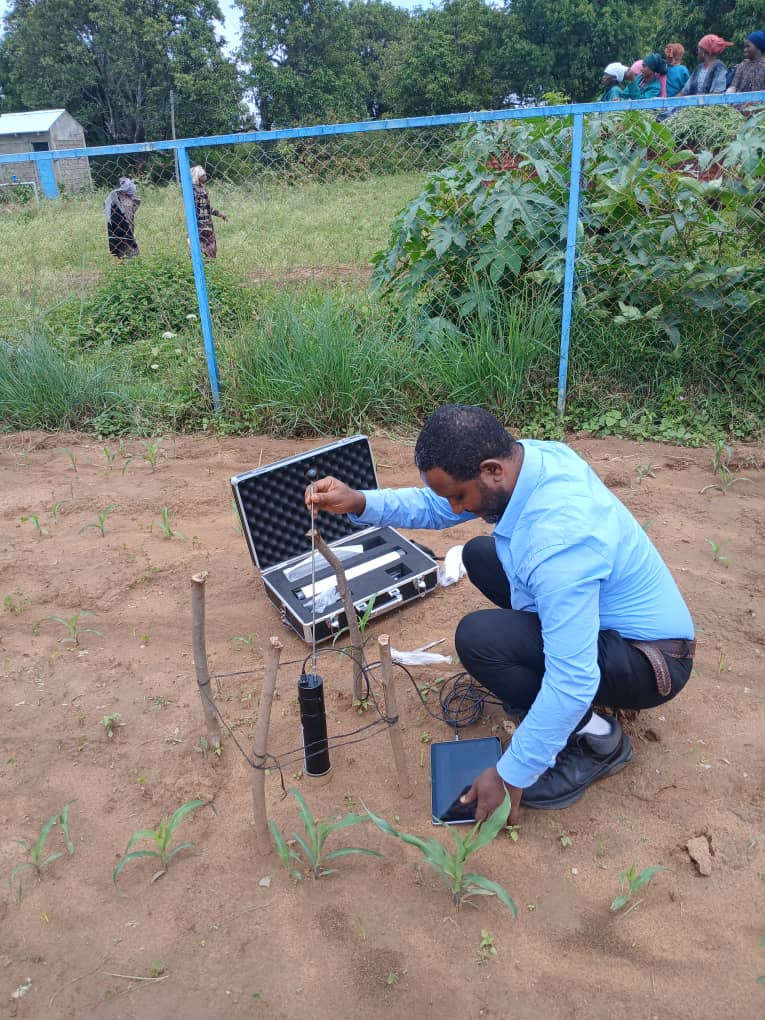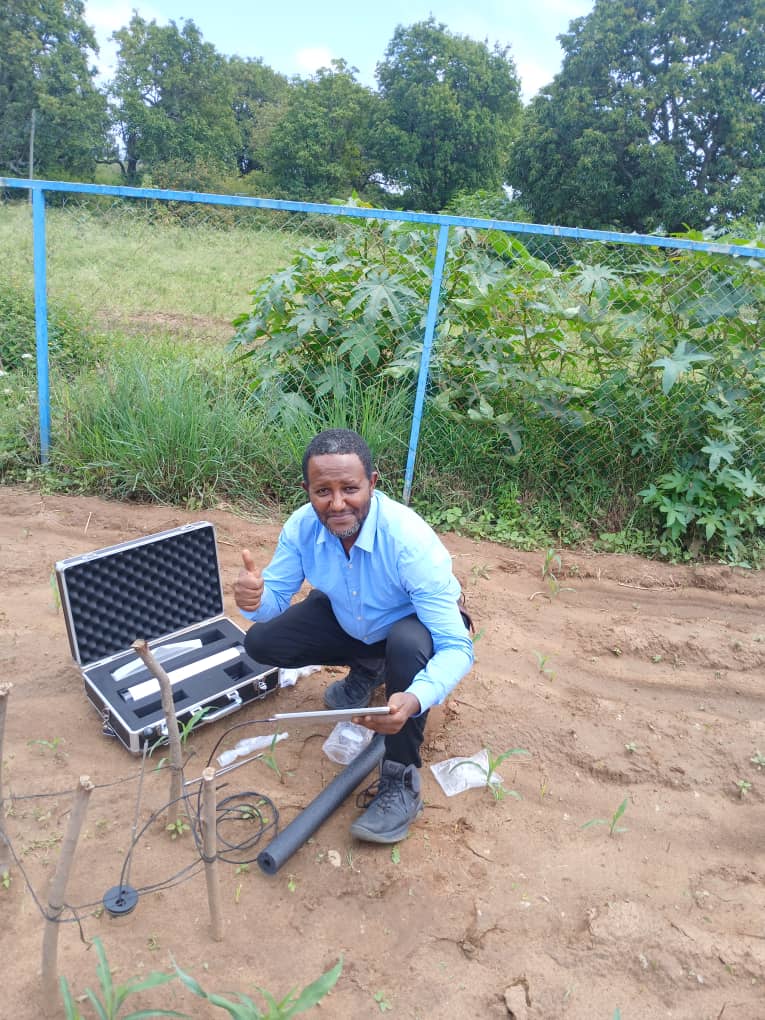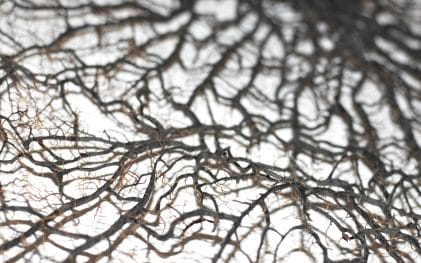August 14, 2025 at 7:57 pm | Updated August 26, 2025 at 7:03 pm | 4 min read
When drought takes hold in the Horn of Africa, the warning signs start below ground, out of sight and, until recently, out of reach. At Haramaya University’s Africa Center of Excellence for Climate‑Smart Agriculture & Biodiversity Conservation, PhD candidate and Assistant Professor Ephrem Mamo Weledekidane set out to change that. His goal: to watch roots work in real time and feed that evidence into a process‑based Mulch‑SPAC (Soil–Plant–Atmosphere Continuum) model that can guide field decisions in rainfed and irrigated systems.
 Ephrem’s motivation is both scientific and personal. Raised in a farming community where a season could be won or lost on a few weeks of rain, he wanted tools that could explain why crops survive or fai, and how simple practices like mulching alter the balance of heat and water in the soil.
Ephrem’s motivation is both scientific and personal. Raised in a farming community where a season could be won or lost on a few weeks of rain, he wanted tools that could explain why crops survive or fai, and how simple practices like mulching alter the balance of heat and water in the soil.
“Most previous studies gave us only seasonal averages,” Ephrem explains. “They couldn’t tell us when water stress would strike during the growing season, or how different management strategies would influence those stress patterns. We needed a way to look deeper – into the soil itself – and understand the processes in real time.”
Making the Hidden Half Visible: CI‑600 in Action
 That is where the CI‑600 In‑Situ Root Imager enters the story. By installing clear access tubes before planting and returning to the same locations throughout the season, Ephrem can observe root length density, distribution, and growth dynamics as they evolve. Those measurements are the missing link for the model’s Root Water Uptake module – turning educated guesses into calibrated parameters and, ultimately, more credible simulations of crop water use and temperature moderation.
That is where the CI‑600 In‑Situ Root Imager enters the story. By installing clear access tubes before planting and returning to the same locations throughout the season, Ephrem can observe root length density, distribution, and growth dynamics as they evolve. Those measurements are the missing link for the model’s Root Water Uptake module – turning educated guesses into calibrated parameters and, ultimately, more credible simulations of crop water use and temperature moderation.
A Model Built for Decisions: Ethiopia’s First Mulch‑SPAC
The modeling framework itself is ambitious: Ethiopia’s first Mulch‑SPAC model that resolves hydrothermal dynamics at daily to hourly scales. To ground the model in reality, Ephrem pairs CI‑600 imagery with an automated weather station above ground and soil‑moisture/temperature profiling below it (e.g., SoilVUE and TEROS sensors). Together, these data streams capture the full continuum, from atmosphere to soil to roots to crop, so that simulated fluxes reflect what the field is actually doing.
Fieldcraft: Turning Tools into a Workflow
Operationalizing a new instrument in rural research settings takes planning. Delivery of specialized equipment can be slowed by customs, so the team advanced simulation development and field preparation while awaiting the CI‑600, then executed an accelerated imaging plan once it arrived. They bench‑calibrated the device ahead of deployment, standardized the time of day for imaging to keep conditions comparable, and built a workflow for organizing high‑resolution images and metadata. The result is a clean, repeatable time series of below‑ground change.
From Snapshots to Seasons: What Changed
Has the approach changed the way the team works? Absolutely. Before, root studies depended on destructive sampling that captured only a moment in time. Now, the group can watch roots respond to rainfall events and mulching in situ, stage by stage. “Before the CI-600, root studies were often destructive and only gave us one-time snapshots,” he says. “Now, we can watch roots grow and respond to environmental conditions over time. It’s a complete shift from static to dynamic understanding.”
Findings That Move the Needle
Early findings are already reshaping practice. Instead of relying on end‑of‑season means, the team can pinpoint when water stress emerges within a season and how mulching shifts soil temperature and moisture trajectories. As CI‑600 data tighten the model’s Root Water Uptake estimates, the simulations return more realistic pictures of water productivity and heat mitigation, evidence that can inform irrigation timing, mulch application, and other field‑level decisions aimed at stabilizing yields.
 Practical Guidance for Peers
Practical Guidance for Peers
For researchers new to the CI‑600, Ephrem’s advice is pragmatic and hard‑won: plan procurement early where customs can slow delivery; install tubes ahead of the season so soil can settle and roots can acclimate; follow installation and calibration guidance closely to protect image quality; and, whenever possible, pair root imaging with weather and soil sensors so the below‑ground picture is anchored to the broader SPAC.
What’s Next
Looking ahead, the team envisions their Mulch‑SPAC model feeding into farmer‑facing decision tools and policy planning, helping Ethiopia move faster toward climate‑resilient, self‑sufficient agriculture. The CI‑600 will remain central to that journey, not as a stand‑alone device, but as the bridge that turns underground reality into decisions that matter above ground.
Research Team Members
Ephrem Mamo Weledekidane – PhD candidate, Assistant Professor at Haramaya University (Africa Climate‑SABC)
Kibebew Kibret – PhD, Associate Professor of Soil Physics at Haramaya University
Bobe Bedadi – PhD, Associate Professor of Soil Physics at Haramaya University
Kindie Tesfaye – PhD, Senior Scientist at CIMMYT-Ethiopia
Tsegaye Tadesse – PhD, Research Professor of Applied Climatology & Remote Sensing at University of University of Nebraska–Lincoln
Semu Moges – PhD, P.E, Senior Hydrologist, Dallas, Texas
Getachew Teshome – PhD, Infectious Disease and Mathematical Modeler at Haramaya University
Related Products
Most Popular Articles
- Transpiration in Plants: Its Importance and Applications
- Leaf Area – How & Why Measuring Leaf Area…
- How to Analyze Photosynthesis in Plants: Methods and Tools
- Plant Respiration: Its Importance and Applications
- The Forest Canopy: Structure, Roles & Measurement
- Stomatal Conductance: Functions, Measurement, and…
- Forest & Plant Canopy Analysis – Tools…
- Root Respiration: Importance and Applications
- The Importance of Leaf Area Index (LAI) in…
- Irrigating with Saline or Seawater

 Practical Guidance for Peers
Practical Guidance for Peers




